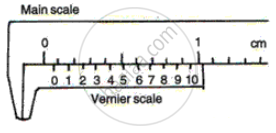Advertisements
Advertisements
प्रश्न
उत्तर

(a) Positive zero error

When two jaws are in contact, the zero of the vernier must coincide with the zero of the main scale. If this is not so, the instrument has zero error. These are of two types:-
a. If the zero of the vernier scale lies to the right of the zero of the main scale then it is called a positive zero error.
b. If the zero of the vernier scale lies to the left of the zero of the main scale then it is called negative zero error
To determine the zero error, note the vernier division coinciding with any main scale division when two jaws are completely closed. Suppose nth division is coinciding with the main scale. Multiply this with the least count of vernier caliper.
Positive zero error = n × L.C.
Negative zero error = - (10 - n) × L.C.
To get the correct reading, the zero error is usually subtracted from the observed reading with its proper sign
Correct reading = observed reading - zero error
APPEARS IN
संबंधित प्रश्न
The final result of the calculation in an experiment is 125,347,200. Express the number in term of significant place when accuracy is between 1 and 10
The final result of the calculation in an experiment is 125,347,200. Express the number in term of significant place when accuracy is between 1 and 1000
Up to how many decimal places can a common vernier callipers measure the length in cm?
State the correction if the negative error is 7 divisions when the least count is 0.01 cm.
Which part of vernier callipers is used to measure the external diameter of a cylinder?
What do you understand by the following term as applied to screw gauge?
Negative zero error
The precision of vernier calipers is ______ mm.
A vernier caliper using the scale invented by Galileo.
